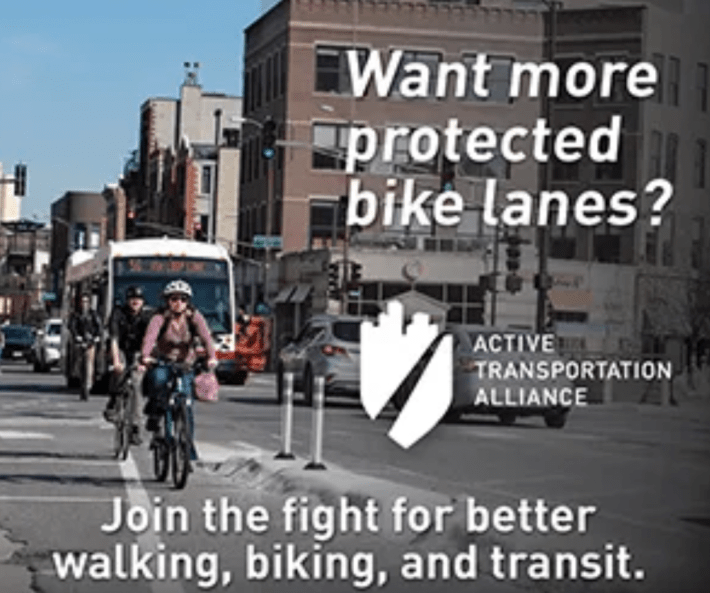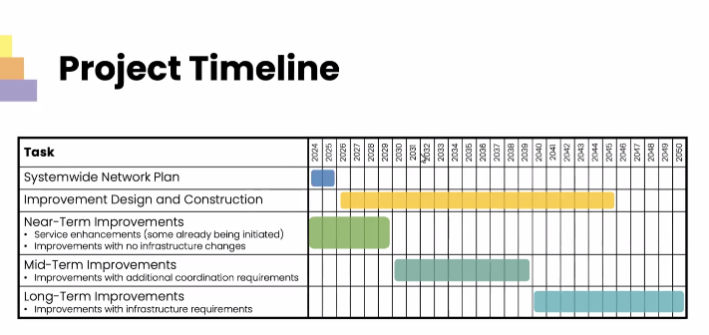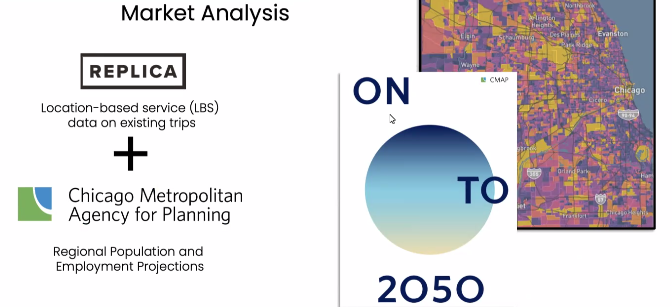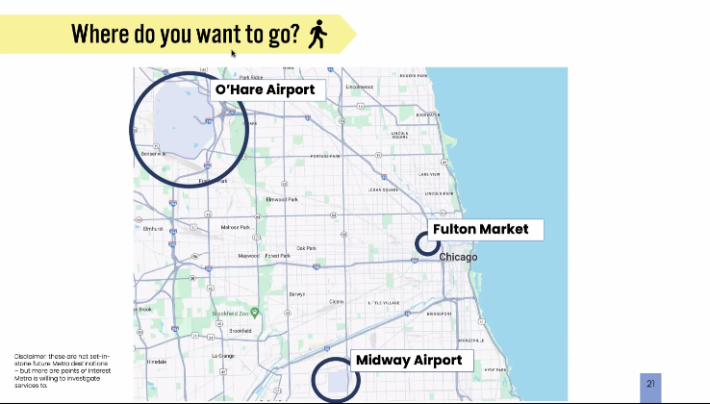
Riders got a chance to sound off on what they wanted to see in Metra’s Systemwide Network Plan during last Thursday’s public meeting, which was held virtually over Zoom.
The commuter rail agency is looking to shift away from the traditional commuter rail model to more of a regional rail service model, which increases off-peak and reverse commuting options. As Streetsblog previously reported – and Metra officials reiterated during the May 30 meeting – the railroad isn’t looking to expand service. It will look into adding infill stations and adding service to "short segments or corridors." Metra is planning to finalize the plans in 2025. Riders may see some smaller-scale improvements before 2030, but the presentation mentioned that large-scale improvements probably won’t be finished until the 2040s.

During the meeting, several attendees argued in favor of Metra using through services; trips that use more than one line; better coordination with CTA and Pace; and more transit-orientated development. Metra also got some flack for relatively limited outreach – an online survey and one meeting. The officials said that they will organize focus groups and hold stakeholder meetings to get more input, and said there will be other public meetings further down the line. But for now, their biggest priority is to get as many responses to the survey as possible before it closes on June 19.
The Planning

According to the meeting presentations, aside from the survey, the community meetings and stakeholder meetings, Metra will use the Replica location service data and Chicago Metropolitan Agency for Planning population and employment projections to see what the travel demand is like now and how it may change in the future.
During the meeting, attendees were asked about their interest in taking Metra to O’Hare International Airport, Midway Airport and the Fulton Market District neighborhood. O’Hare does get Metra service, with the North Central Service line stopping right next to the O’Hare Multi-Modal Facility.

With Fulton Market access, there are two sets of tracks – one shared by the two Milwaukee District lines and North Central Service, and one used by Union Pacific West line. Providing a local station would be a matter figuring out where the stop would be built and constructing it.
As for providing a Midway Metra station, the lift is much heavier. The closest Metra line, the Heritage Corridor, is more than a mile north of the airport and is rush hour-only. There is a two-track Belt Railway-owned freight line on the north side of the airport, but Metra would need to get the freight company’s permission to use it, and figure out how to get the trains to the Chicago Union Station – a process that may involve more railroads.
The survey questions were framed as whether the attendees would take Metra to those destinations if the trains were as fast or faster than traveling by car. Putting in "I would ride Metra if it’s faster than CTA or Pace" wasn’t an option. With that caveat in mind, the majority of respondents were interested in taking Metra to O’Hare, but there was less interest in taking Metra to Fulton Market and Midway.
Attendee questions
Several attendees asked about the possibility of doing through service – in other words, having the trains travel more than one line. Pace has "paired routes," CTA has the “Ravensway” trains, rush hour Brown Line trains that become Orange Line trains after they reach the Loop, and vice versa. Metra currently doesn’t have anything like that, but before the pandemic, it operated Train #120, an evening inbound train that started as North Central Service train, switched to the Milwaukee District North line at Prairie Crossing, stopped at Libertyville and Lake Forest stations, and ran express the rest of the way.
David Kralik, Metra’s director of programming and operations, responded that, while it is something Metra will research as part of the planning process, "right now, we don't have the tracks that we control that allow through-routing of services."
While there are no through tracks directly connecting the four downtown terminals, Amtrak-owned Chicago Union Station does have two tracks connecting the otherwise separate North and South concourses. This can theoretically allow Metra to run one-seat rides between, for example, O’Hare and Joliet.
(Just this Memorial Day weekend, I happened to be on a Hiawatha train that got sent from the usual North Concourse to the South Concourse. The experience was so seamless I didn’t immediately realize what was happening.)
Aaron Maertins, Metra’s director of operations and project management, was asked whether the planning process could involve better schedule coordination with CTA and/or Pace. He said that all three transit agencies share schedule changes with each other, but Metra can’t make CTA or Pace do anything with that information.
Asked whether the plan would create any suburb-to-suburb services along the lines of the STAR Line concept, Kralik said that there wasn’t enough demand to justify it. He added that the tracks that would’ve been used by the STAR line are fairly freight-heavy, which doesn’t help.
Metra officials were also asked whether the railroad is planning to do anything to encourage transit-oriented development near its stations as a way to boost ridership. Kralik said Metra is looking into potentially making some of the commuter parking lots available for development.
"We're in the process of looking to right-size parking lots around our stations," he said. "There's an opportunity to work with local communities to make those parking lots available for development."
But Kralik added that it’s something Metra would do on a case-by-case basis. "We also want to make sure that we have a growth mindset and have sufficient parking to accommodate not just what we're experiencing today, but our growth projections to medium and longer terms."
Miscellaneous Updates
Many questions were more about Metra in general than the plan specifically – which did lead to a few updates.
• North Central Service is expected to get some of its pre-pandemic evening service back, but the weekend service is still not happening due to contractual agreement with Canadian National.
• Metra and the University of Illinois Chicago are working on a pilot that would create a Metra version of a U-Pass, a CTA/Pace pass that college students pay for through the activity fees. The BNSF Line’s Halsted station serves the university’s South Campus, and the service improvements over the past few years made it a more viable transit option. Maertins said that the two sides are still finalizing the details, but they hope to launch the pilot in time for the fall 2024 semester. If it’s successful, the railroad hopes to expand the pilot to other Chicago area colleges.
• The fate of the BSNF Line extension to Kendall County is up in the air. Kralik said that, now that Metra completed the service extension study, the ball is now in the county’s court. The service can’t happen unless the county either joins the Regional Transit Authority – which oversees local transit funding allocation – or comes up with some other way to cover the initial construction and pay for ongoing operations.

Did you appreciate this post? Please consider making a tax-deductible donation to help fund Streetsblog Chicago.





